This is a Royer Teleroy, a medium format folding camera made in France by Société Industrielle de Technique Optique, or SITO for short, starting in 1950. The Teleroy featured a coupled rangefinder and shoots both 6cm x 9cm and 4.5cm x 6cm images on 120 or 620 roll film. This was a premium camera that has a solid all aluminum body, a self timer, and came with either SOM Berthiot or P.Angenieux f/3.5 lenses. The Teleroy is very rare today, and is hard to find even in France, suggesting that not many were made.
Film Type: 120 or 620 Roll Film (eight 6cm x 9cm or sixteen 4.5cm x 6cm exposures per roll with additional mask)
Lens: 105mm f/3.5 SOM Berthiot Paris Flor coated 4-elements
Focus: 2 meters to Infinity
Viewfinder: Scale Focus Viewfinder with Separate Split Image Coupled Rangefinder
Shutter: Royer Leaf
Speeds: B, 1 – 1/300 seconds
Exposure Meter: None
Battery: None
Flash Mount: ASA Flash Sync Port (probably flashbulb synced at all speeds)
Weight: 816 grams
Manual: https://mikeeckman.com/media/RoyerTeleroyManual.pdf
How these ratings work |
The Royer Teleroy was both the highest featured folding Royer camera, but also one of the coolest 6×9 folding cameras I’ve ever handled. The build quality of the camera is excellent, it comes with an excellent lens, and it has a very unique split image rangefinder that is entirely contained on the shutter with no linkage back to the main body. This is a benefit as without any body linkage, there’s less to go wrong, but also, it means the rangefinder assembly can be installed and removed onto other non-rangefinder equipped Royers. The camera is big and heavy, so what it lacks in portability, it more than makes up for in large and highly detailed images. I thoroughly enjoyed shooting the Teleroy and will keep it in my permanent collection for years to come. | ||||||
| Images | Handling | Features | Viewfinder | Feel & Beauty | History | Age | |
| 2 | 1 | 2 | 2 | 2 | 1 | 30% | |
| Bonus | none | ||||||
| Final Score | 13.0 | ||||||
History
My luck with French cameras can best be summed up as “three times a charm”. My first two attempts at reviewing a camera made in France were the Fex Ultra Fex and the OPL Foca PF3, both of which turned out to be inoperable and were reviewed as part of my Cameras of the Dead series. When I had a chance to review this Royer Teleroy, I was sure to take many deep breaths. Before I get to my results however, here’s some history…
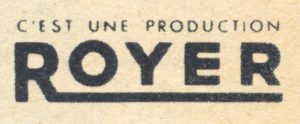 The name Royer does not refer to a company, rather a brand of cameras produced in France by Société Industrielle de Technique Optique, or SITO for short from about 1948 until the mid 1960s. The company was founded by an optical mechanic named René Royer who had previously worked for the French cinematography company, Lumière during the war.
The name Royer does not refer to a company, rather a brand of cameras produced in France by Société Industrielle de Technique Optique, or SITO for short from about 1948 until the mid 1960s. The company was founded by an optical mechanic named René Royer who had previously worked for the French cinematography company, Lumière during the war.
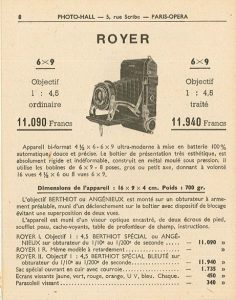
After World War II, the French government instituted some protectionist measures to help speed up the recovery of French industry by forbidding foreign imports in numerous sectors of the economy, including photographic equipment. As a result, a number of small photographic and optical companies were created to fill a void of imported photographic goods that could no longer be obtained from Germany and other countries.
Sensing an opportunity to branch out on his own, Royer left Lumière to form his own company and start making cameras under his own name. Royer had experience with folding medium format cameras from his time at Lumière so those were some of the first models produced starting in 1948.
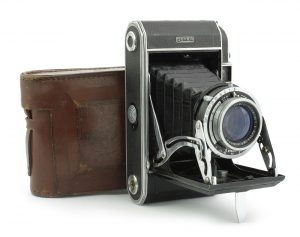
The first cameras, simply called the Royer I and II were inexpensive 6×9 folders that came with either Berthiot or Angénieux lenses in a simple leaf shutter.
In the years that would follow, a large number of variations of that original Royer camera would be created, with incremental changes including better lenses and shutters, some with flash synchronization and others with self timers. The basic body of Royer 6×9 folding cameras would be retained for a while, even on the company’s higher end models.

In 1950, a top of the line model called the Royer Teleroy was created with the company’s first ever rangefinder. The prefix “tele-” in the camera’s name is short for telemeter, which is another word for rangefinder, hence the ‘tele-Roy’ or rangefinder Royer.
In an article published in 1950 in Photo-Ciné-Revue, René Royer talked about the convenience of optical rangefinders in compact cameras, but that a lack of reliable options existed for larger cameras. The challenge, he said for rangefinders in folding cameras comes in the complex coupling required to link the focus distance of the lens to the rangefinder in the body of the camera. Although medium and large format rangefinders did exist at the time, they were difficult and expensive to build.
Royer sought a simpler method that would allow a rangefinder to exist entirely on the camera’s shutter which would eliminate any need for coupling to the camera’s viewfinder on the body. Thus the idea of the Teleroy was born.
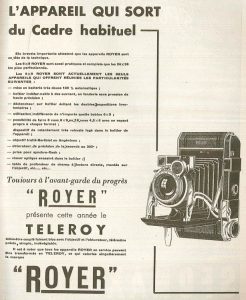
Royer’s design for the Teleroy’s rangefinder meant that no changes were necessary to the main body of the camera and that a rangefinder unit could be added as an option to existing, non rangefinder Royer cameras. The ad to the left makes the bold claim that all Royers can be converted to the Teleroy by simply swapping the shutter.
This suggests that at least some rangefinder equipped Royer cameras exist out there that were converted at some point after they were first sold, but how many, and how much this cost is anyone’s guess. Original, non-converted Teleroys will have the Teleroy name engraved into the top plate above the viewfinder, but I suspect that converted ones do not have this engraving.
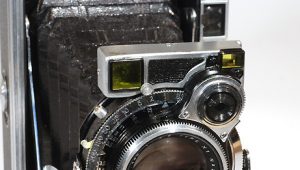
I have seen at least two subtle revisions to the Teleroy’s rangefinder. Some, like mine, have a clear glass rangefinder window, and others have it tinted yellow. I am not sure if one is an earlier or later variation, or if this is a filter that could be added later.
Since most of France’s film industry was there to serve the interest of domestic photographers, I am not certain that many of the company’s products were exported. I found no English language translations of any advertisement or promotional material about any of Royer’s folding cameras including the Teleroy.
I also could not find any pricing for the Teleroy, but a non-rangefinder Royer IV RS with Angénieux f/3.5 lens and flash synchronized 1/300 shutter sold in 1950 for 18.270 francs, so that suggests a Teleroy was a bit more than that, perhaps somewhere around 20.000 francs. If this price is correct, converting it into US dollars accounting for inflation is mostly guesswork, but if the estimation at historicalstatistics.org is correct, the Teleroy might have sold for something close to $1220 today.
Finding specifics about how long the Teleroy was in production or how many were made is difficult, but Sylvain Halgand’s collection-appareils.fr website suggests it was produced until 1955 or 1956 which is as good of a guess as any.
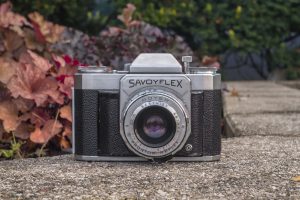
It is not clear when this happened, but by the mid 1950s, the name SITO would no longer appear on the company’s advertisements, instead all cameras being referred to as being made by Royer. It is not clear whether or not SITO officially changed it’s name to Royer to identify with it’s most popular product, or if this was just a rebranding. Whatever the case, Royer would continue to produce other cameras, including a large number of 35mm cameras starting with the simple Savoy scale focus camera, and peaking with the auto exposure Savoyflex Automatic SLR.
Today, folding 6×9 cameras are collectible. Folding 6×9 rangefinder cameras are collectible. Folding 6×9 rangefinder cameras made in France are collectible. I’m just not sure of how collectible folding 6×9 rangefinder cameras made in France called the Royer Teleroy are. This isn’t because there’s anything wrong with them, but rather, not too many people have heard about them. It is hard to collect something if you don’t know it exists.
If you wanted to add a Teleroy to your collection, all I can say is good luck as these do not show up for sale often, and when they do, maybe you’ll get lucky and they’ll fly under the radar of all other collectors, or you could find yourself in the midst of a bidding war.
My Thoughts
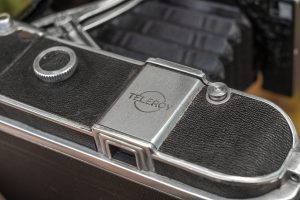
Obscure French folding cameras aren’t exactly easy to come by in the United States. I can count on one hand how many French cameras I can name off the top of my head, so last summer when I saw a ten camera auction from KEH for not one, but five different French folding cameras, I took notice. After winning the auction, I couldn’t wait to start playing with them.
To be perfectly honest, the Teleroy wasn’t at the top of my list as there were a couple others that I thought were cooler, but it wasn’t until I handled it and saw it to be in nearly perfect working condition that this camera jumped to the top of my list.
For starters, the camera’s all aluminum die cast body is very solid and does not creak in your hands like a stamped metal camera might, but it’s also not as heavy as some German or Soviet 6×9 folders. At 816 grams, the Teleroy is almost identical in weight to a Kodak Tourist, which has a plastic top plate.
For the rest of this article, I’ll refer to the side of the camera with the viewfinder to be the “top” of the camera as it’s the most logical side to be facing up while you hold it to your face.
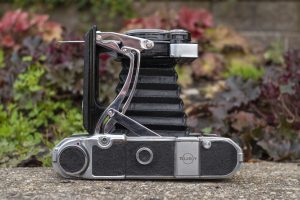
From left to right, there is the film advance knob, which if you look closely, is the only place on the camera where the words “Made in France” are. Next is the shutter release button that is internally threaded for a cable release. The shutter release is coupled with the film advance knob for double exposure prevention. You must rotate the knob in order to defeat the interlock. This location for the shutter release button makes it an easy reach for your left index finger.
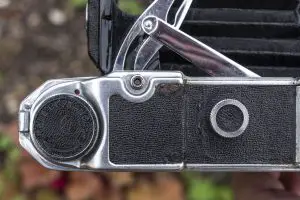
In the middle of the top plate is an unlabeled dial which is the camera’s self timer. The self-timer is also coupled to the double exposure prevention coupling on the film advance knob, so the self-timer cannot be activated until the advance knob has been turned. What’s interesting about this self-timer, is that it is not connected to the shutter. It merely triggers the shutter release button, which has a series of linkages that connect it to the shutter’s actual shutter release on it’s side. I have seen some Teleroys without a self-timer, so it’s possible that this was either an option, or a mid-model variation.
To the right of the self-timer knob is a raised portion for the optical viewfinder. This being a genuine Teleroy, there is an engraved logo in the exposed metal, above the viewfinder. At the time the Teleroy was being sold, Royer offered an upgrade to non rangefinder equipped folding Royers essentially turning them into a Teleroy, but these upgraded cameras would not have the logo here.
Finally, to the right of the viewfinder is a small release button for opening the camera. This button has the look and is in the location of where a right handed shutter release might be, which I assume has fooled a few users over the years, but pressing it with the camera already opened, does nothing.
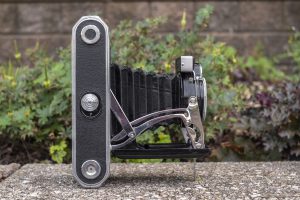
Flipping the camera over to the bottom, all that’s here is a 3/8″ tripod socket, the sliding release for the film compartment and a foot opposite of the tripod socket to level out the camera when set on a flat surface. Modern tripods use a 1/4″ tripod bushing, so if you wanted to mount this camera to a tripod, you’d need an adapter.
Opening up the camera requires sliding the door lock on the bottom to the side with the letter “F” on it. On my example, this lock slid extremely easily, and although it never happened to me, I could see how it could accidentally get moved, unintentionally opening the camera. It is plausible that other Teleroys don’t have such an easy to release lock and this issue is unique to mine, but if you get a camera, that’s something I would definitely check.
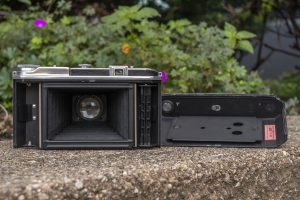
With the back off, we see a rather ordinary 6×9 roll film compartment. When this camera was new, it would have come with a removable mask to shoot “half frame” 4.5×6 exposures, but that part was missing from my example. Film travels from right to left onto plastic, wood, or metal spools. The Teleroy supports either regular 120 or Kodak 620 film. It is able to accomplish this by using a stepped key beneath the film advance knob that can fit into both the smaller notch on a 620 spool and the larger notch on a 120 spool.
Both the supply and take up side have a spring tensioned arm to hold each spool in place and is very easy to release. Since the bottom of the camera comes off with the back, I had no problems loading or unloading film into the Teleroy compared to other roll film cameras with a rigid bottom. On the inside of the door is the large and textured film pressure plate and a neat French language sticker that suggests buying only Royer branded filters and accessories.
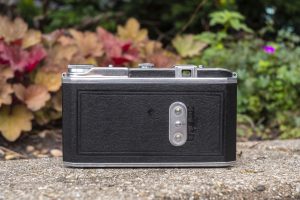
With the back of the camera attached to the body, the rear of the camera has twin red windows, one each for 4.5×6 and 6×9 images. Both windows are covered by a swiveling metal plate to protect the film from excess light. Interestingly, a few sites online suggest the Teleroy supported 6×6 images, not 4.5×6. A French language ad on Sylvain Halgand’s collection-appareils website states that the Teleroy shoots 6×6 images yet my camera has a second window that is labeled for 4.5cm x 6cm. With film loaded in the camera, exposure numbers 1 through 16 clearly show in the 4.5×6 window, suggesting this was not a misprint.
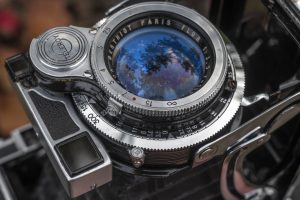
Up front, the Teleroy is dominated by the large 105mm f/3.5 SOM Berthiot Paris Flor lens, and it’s vivid blue lens coating. The lens is set in an unnamed rim set leaf shutter that looks like it’s probably a copy of the Compur Rapid shutter. Speeds from 1 second to 1/300 are chosen by the outer dial, and f/stops from f/3.5 to f/32 with a sliding lever around the edge of the dial. A red dot is printed in between f/8 and f/11 on the aperture scale which corresponds to a second red dot on the focus scale between 7 and 15 meters, both indicating recommended settings to use the camera for fixed focus snapshots. A depth of field scale is printed on the inner ring which suggests that lining up the red dots will allow for everything between 6 meters and just under infinity to be in focus.
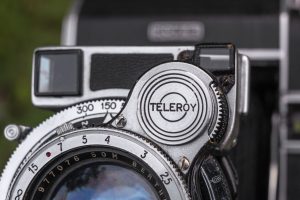
The SOM Berthiot Paris Flor is a unit focusing lens, which means the entire front group is rotated from just under 2 meters to infinity, but a smaller serrated wheel behind behind the rangefinder coupling can also be used to change focus. The location of this smaller coupled wheel falls perfectly in place for your right index finger with the camera to your eye, not that much different from the focus wheel on a Zeiss-Ikon Contax or Nikon rangefinder.
The Teleroy’s viewfinder is just a straight through optical viewfinder which approximates the 6×9 field of view that will be captured on film. There are two small teeth at the top of the frame that approximate a 4.5×6 image for when the mask is used. Where the Teleroy gets it’s name from, is the coupled rangefinder which is cleverly contained in a module above the shutter.
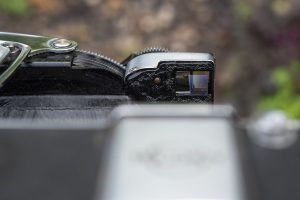
I say that the Teleroy’s rangefinder is clever because a challenge involved with coupled rangefinders on folding cameras is that there usually has to be some kind of link between a moving mirror or prism in the viewfinder for it to work. On cameras like the Kodak Retina, as the focus distance of the lens is changed, a helix moves back and forth within the camera body that moves a metal pin which is physically connected to a moving mirror in the viewfinder. Zeiss-Ikon got around a physical connection between the viewfinder and lens on cameras like the Contessa 35 by using a rotating glass lens above the shutter that when viewed through a special prism in the viewfinder, causes the rangefinder image to move.
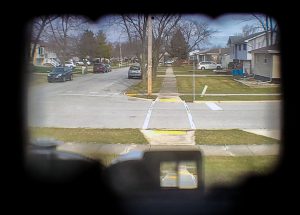
The Teleroy uses two glass prisms, one of which is connected to the coupling wheel on the lens which moves a split rangefinder image that can be seen simply by angling your eye down while looking through the main viewfinder. The Teleroy’s rangefinder is entirely self contained, much like an auxiliary rangefinder mounted to an accessory shoe might be, except it is in a location where you can see it while composing your image through the viewfinder. Unlike most other split image rangefinders, the Teleroy’s is vertical, kind of like the one in an Alpa Alnea Model 7. This is a bit awkward to use at first, but works exactly the same as horizontal rangefinders, just turned 90 degrees.
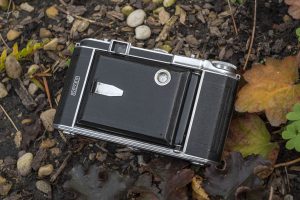
In use, I found the rangefinder to be very effective. It’s small, but no worse than others found in folding cameras of the day. Since it uses glass prisms instead of beamsplitters, the image was very bright and had no symptoms of haze or fogging like is common on mirror based rangefinders.
The Royer Teleroy is a fantastic camera, both in it’s features, design, and functionality. When folded shut, it is a solid piece of metal that fits easily into a large coat pocket or small hand bag, which when considering the large 6cm x 9cm images it produces, makes for a capable camera. I don’t often reach for a 6×9 folding camera when I take a casual stroll around the neighborhood or on a family trip to the zoo, but perhaps that’s because I have never found the perfect 6×9 folding camera. Is this it?
My Results
For the first roll of film in the Teleroy, I chose Kodak Ektar 100. Over the summer I had accumulated a good number of rolls of this film, and feeling like I was neglecting it, I loaded it up and went shooting. Although the Teleroy has a top 1/300 shutter speed, I knew from experience, top shutter speeds on half century old folding cameras are hardly accurate, so I felt more comfortable using a 100 speed film and using the shutter at it’s middle speeds.
Before I comment on the images in the gallery above, I am ashamed to admit that for my first roll through the Teleroy, I had some issues with the development. Normally Kodak Ektar is a pretty straightforward color film to develop, so I am not sure if I lost track of time or my temps were off in the soup as this film was developing, but there was a noticeable color shift in the images it produced, that I in no way fault the camera for.
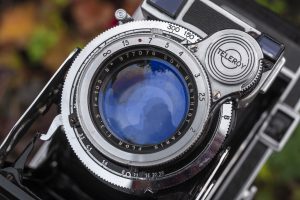
Other than strange colors, the rest of what’s here is quite good. For as popular as 6×9 cameras were in the early to mid 20th century, covering the entire 108mm distance corner to corner is a stretch for many low to mid grade lenses. Thankfully, the SOM Berthiot Paris Flor is not a low to mid grade lens.
Center sharpness is as good as any camera out there, with just a hint of vignetting and softness to the corners. The Teleroy delivers a wonderfully rendered image that is not so perfect as to not have any character, but is clearly several steps up from cheap Kodak or low end Zeiss folders of the day. In the image of the toy tractor, there is some “swirley bokeh” going on in the background, similar to what people go crazy for over with Helios 44 lenses. This wasn’t a look I was intentionally going for, but now that I know that it can be done, I will likely try to replicate with future rolls through this camera.
Although not an optically perfect lens, the SOM Berthiot Paris Flor gave me some of my favorite images I’ve ever shot through a 6×9 camera. Add to that a fun to use camera with a very cool and easy to use rangefinder, and the Teleroy is an absolute winner.
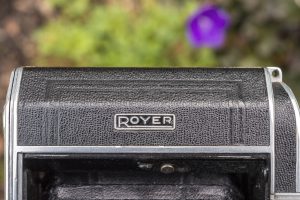
In an effort to balance my adulation a bit, the Teleroy isn’t perfect. I did miss focus a couple of times, not because I think the rangefinder is off, but in my inexperience in using the camera, I found that finding horizontal lines for the vertical rangefinder was a little more difficult than finding vertical lines using a standard horizontal rangefinder. You’d think that there is just as many horizontal lines in the world as there are vertical ones, so my only explanation is that I needed more practice.
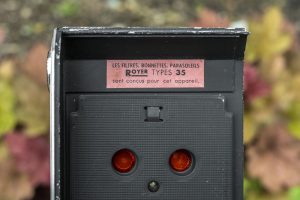
The ergonomics are really good with the camera at eye level horizontally. I found the location of the rangefinder coupling wheel to be perfect for my right index finger, and although I am right handed, using the left handed shutter release was not difficult at all.
It is clear that this camera is intended to be used in landscape orientation as the location of the controls make using it in portrait orientation very awkward. I tend to shoot 6×9 cameras in landscape most of the time, so this wasn’t really a con for me, but for anyone wanting to shoot some vertical portraits, you might struggle. Although I never took any shots like this, practicing with the camera in preparation for this review, I found that portrait shots were the closest to comfortable for me with the camera upside down, my left hand above the camera, and using my left eye to look through the viewfinder.
I mentioned earlier that I had never heard of or seen a Teleroy before and when I spotted the lot of cameras that it came in, it wasn’t even the one I was most excited about, but now that I’ve used it, this is a very special camera and one that has become a favorite in my collection.
I feel sort of bad going on and on about how much I like this camera, fully knowing how uncommon they are. I was lucky to get this camera in a lot with other stuff, because by itself, prices are quite high, and at a level I wouldn’t have otherwise been able to afford. But sometimes things fall in your favor, and they definitely did with this camera.
Related Posts You Might Enjoy
External Links
http://camera-wiki.org/wiki/Royer
https://www.collection-appareils.fr/x/html/appareil-1576.html


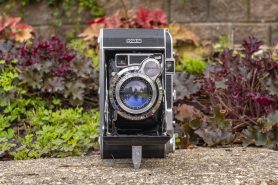
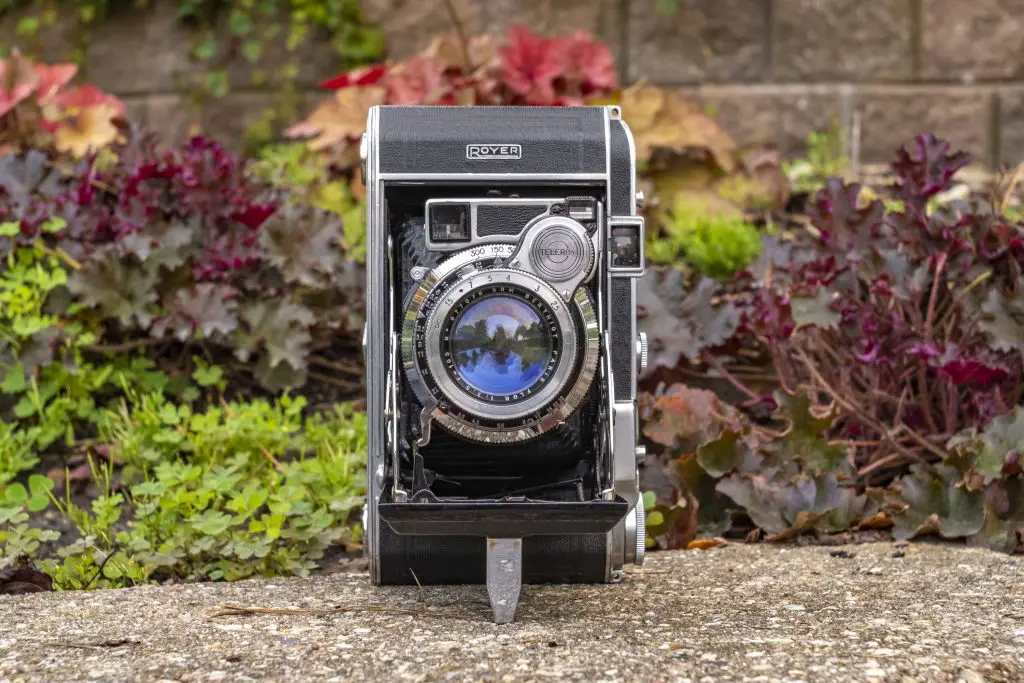







Thanks for reviewing a most unusual camera, Mike. A quick check of eBay shows that “wish-for-leica”, a reliable seller in the Netherlands, has quite a few Royer folders as well as Savoy 35mm rangefinders and Savoyflexes for sale, at (as you said) high prices. No TeleRoyers are available at any price.
.
On another point: Can you remember what you did differently in your C41 processing? The color saturation and “sunset” color shift in several of the photos in this post are beautiful, and worthy of duplicating!
I honestly don’t know what I did wrong in my C41 developing. If I had to guess, I probably had the temperature wrong. I am pretty good about keeping an eye on my stopwatch for the timing of each step of the process, but I often take a laissez-faire approach to the temps. Thanks for the compliments though. I have more reviews planned this year from the 10 camera lot that this one came in, and they’re all interesting models that you don’t get to read about often. Stay tuned! 🙂
What a wonderful acquisition. I want one! Indeed rare, as you said. And one of those rarities you promised us. Just one on ebay.co.uk with an opening bid needed of the equivalent of $300, based on the current rate of £/$ exchange. And this is for a camera looking cosmetically much inferior to yours and being not working or for parts, too!
Optically, the images are impressive, easy to see why it’s a keeper, and set me wondering how it would fare coming up against one of the last Super Ikontas with a coated Tessar.
Thanks for this great site !
I’m writing from France, and I can testify that even from here it’s not easy to find a Teleroy in good condition. I have one too, but as much as I do appreciate the excellent built quality and the high-quality Flor lens, I find it rather difficult to use in real life, mostly because of the rangefinder and shutter’s unnusual ergonomy. But that’s just my opinion, and probably I haven’t used it often enough to get used to it.
By the way, have you ever had a chance to test it’s competitor on the French market : a Demaria Lapierre Telka III ?